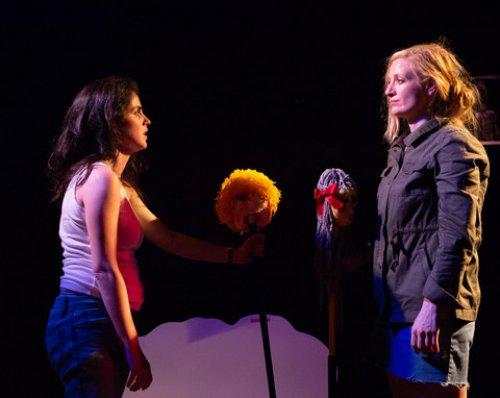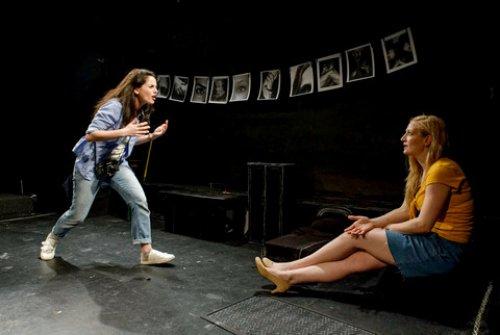Butterflies
Emanuele Aldrovandi’s play about sisters playing a dangerous game of dares is too talky and overblown to grip the audience, but the two performers shine.

Annie Watkins and Danielle Sacks in a scene from Emanuele Aldrovandi’s “Butterflies” (Photo credit: Tom Henning)
[avatar user=”Mark Dundas Wood” size=”96″ align=”left”]Mark Dundas Wood, Critic[/avatar]
Some dramatists have a penchant for characters who indulge in mind games—ritualistic, literal games. Such scenarios were especially popular in the U.S. in the early-to-mid 1960’s. Think of Who’s Afraid of Virginia Woolf’s George and Martha calling for a brisk round of “Get the Guests,” or the Boys in the Band boys daring one another to blurt out midnight love confessions over the phone. Such scenes of psychological warfare, when executed correctly, can grip audiences, instilling feelings of suspense and dread, especially when the stakes escalate with each new round played.
As with any theatrical fad, though, these psycho-dramatic showdowns can eventually grow tiresome: the 1960’s fondness for the genre apparently dwindled. Virginia Woolf’s Edward Albee did this kind of thing so very well. Did playgoers really need an unending line of pale replicas in the decades after he wrote his masterpiece?
Italian playwright Emanuele Aldrovandi has attempted to resume the tradition with Butterflies, a play about a pair of sisters—known only as Blonde and Brunette—who have long been each other’s whole world. Their mother has committed suicide; their nasty work of a father has more or less abandoned them (except when he occasionally decides to turn up to impose his will on them). Because their feelings for each other are so deep, each has a need to test the other, to make her demonstrate love and loyalty. They do this with a ritual involving a hairpin with a butterfly design. Whichever sister holds the pin can demand something of the other. If the challenged sister won’t “play,” then the game is over—and that’s unthinkable. Therefore, care must be taken always to demand something that the other sibling won’t refuse. It’s “a little cruel,” Blonde says, “but it’s addictive.”

Danielle Sacks and Annie Watkins in a scene from Emanuele Aldrovandi’s “Butterflies” (Photo credit: Tom Henning)
Butterflies, which won the Mario Fratti Award at New York’s “In Scena!” theater festival in 2016, has been translated by Carlotta Brentan and directed by Jay Stern in a production at Manhattan’s The Tank. It’s an earnest endeavor, and the two young women playing the sisters (Annie Watkins as Blonde and Danielle Sacks as Brunette) both give strong performances. The play, though, is talky and overblown. Perhaps Aldrovandi’s original has lost something in translation, or maybe his play draws on Italian cultural and theatrical conventions that don’t sit so well with American audiences. In any case, Aldrovandi hits no bullseyes with this production.
Though intermission-free, the play is divided into three short acts, each of which reveals different moments in the lives of the characters. We first see the sisters when they learn that their monstrous father and ridiculous stepmother have demanded that they marry a pair of mentally deficient brothers. We next find them a few years later. Blonde has married one of those brothers and is widowed with two children. Brunette has remained single and has pursued a career as a war photographer. Finally, we see them after a few more years have passed. Blonde is now seriously ill, and Brunette, who previously expressed a dislike for children, has become a devoted mother.
In each act, Blonde and Brunette find it necessary to play the Butterfly game, and it exposes their fears and distrust regarding each other. The game is something only the two of them can share. Brunette says that it’s “sacred because it’s sacred.”
Watkins and Sacks are the best thing about the show. Each has some fine moments onstage. Sacks, in particular, gives a sensitive and nuanced performance. (She also sings quite a bit, displaying a lovely voice.) The actors are at their best in the third act, which starts out nicely directed—that is, until things get noisy, frantic and unfocused. In addition to their main roles, Watkins and Sacks competently (and, often, humorously) portray an array of other characters: fertility specialist, tattoo artist, undertaker, etc. They supply the voices and hand movements, too, for the father and stepmother, who are represented, respectively, by a dust mop and a string mop, both with attached faces.

Danielle Sacks and Annie Watkins in a scene from Emanuele Aldrovandi’s “Butterflies” (Photo credit: Tom Henning)
The play begins on a bare stage, which eventually becomes filled with props. Lighting designer Kyle Soble and costumer Polina Roytman have made serviceable but not especially noteworthy contributions. Sarah Edkins’ scenic design includes tiny beds and other miniature furniture, fit for a household full of elves. The actors are actually called on to perch on these pieces. It’s sort of interesting, but who knows exactly what it’s supposed to signify?
1962—the year in which Who’s Afraid of Virginia Woolf? debuted—also saw the release of the hit film Whatever Happened to Baby Jane?—a grotesque story of two sisters in the grip of an ongoing struggle with each other. Perhaps if Aldrovandi and Stern had brought a campy touch of Baby Jane’s “Grand Dame Guignol” spirit to Butterflies, this production would have better succeeded. Or maybe not. In any event, the situation here never draws us in in the way the playwright wants it to.
Butterflies (through June 8, 2019)
Co-Produced with Kairos Italy Theater
The Tank, 312 West 36th Street, in Manhattan
For tickets, call 212-563-6269 or visit http://www.thetanknyc.org
Running time: 100 minutes without an intermission






Leave a comment